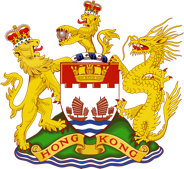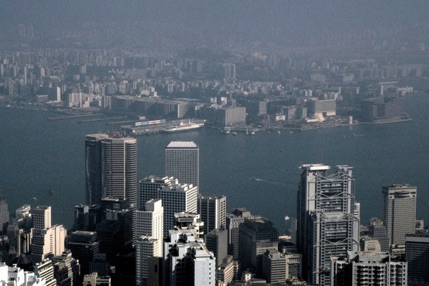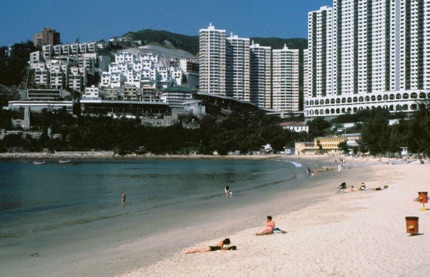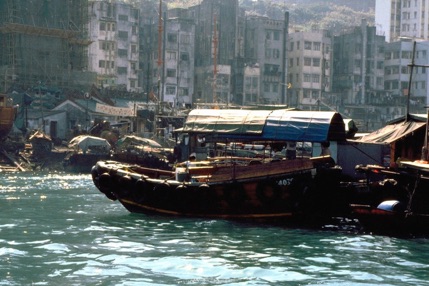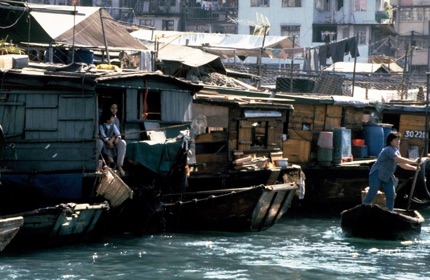China 1985

Kyrgyzstan and Tajikistan 2018

Before breakfast this morning, I did my ritual early morning street walk to get to know the area. It was fascinating. Across the road from the hotel, and in clear view from my window, was Victoria Park, one of the few large expanses of greenery in the city area of Hong Kong. In the early morning, it is full of local people, mostly in business suits and English style school uniforms, doing tai chi exercises, wushi and jogging.
After an excellent, huge breakfast that turned out to be my main meal for the day, we had our half day Hong Kong Island tour. We began at Tiger Balm Gardens (presumably because there was no entrance fee for the guide to pay). Like the one in Singapore, it is a peeling concrete piece of Chinese kitsch. More interesting to see in Tiger Balm Gardens than the gardens themselves were the nearby shanty huts on the steep slopes. Despite the government's massive public housing schemes, Hong Kong still has an acute housing shortage, and shanties are found in several parts of the colony on land which is too steep for any other purpose. Interestingly, many of the shanties were flying Taiwanese flags, a comment I suppose on the fact that China will take over sovereignty of Hong Kong in 1997. I would have thought that the residents of the shanties would have had the most to gain from Chinese sovereignty; perhaps they are simply the most recent refugees from China?
From Tiger Balm Gardens, we visited the Peak, from where the famous views of the Harbour, the Central Business District and Kowloon Peninsula across the water can be seen. We then proceeded to Repulse Bay, a beach overlooking the South China Sea. Surrounded by high rise developments, the beach was also home to a Buddhist temple dedicated to the Sea Goddess, resulting in some of the most unusual seaside decorations I have ever seen –large statues of fish and human figurines, pavilions, bridges which do not cross anything, obvious, spirit houses, and so on.
From Repulse Bay, we travelled to Aberdeen fishing village, if you can call a settlement of tens of thousands of people in high rise flats a village. While at Aberdeen, eight of us went out onto the water in a water taxi through the moored blocks of fishing vessels and boat people. It is an area of amazing contrasts, with obviously very poor people spending much of their lives on the boats and modern high rise housing projects providing a backdrop. We saw hand propelled boats taking fast food from boat to boat, a ship building yard where they still build boats without plans to centuries old designs, fish on overhead lines being dried in the sun, and life on board the boats.
After lunch, we paid courtesy calls on the two schools in Hong Kong, Wah Yan College Hong Kong (WYHK) and Kowloon Wah Yan College (KWYC). We travelled by tram and then by foot to WYHK (Geographers, such as myself, map in hand. are very handy on occasions such as that, even handier than local students’ supposed knowledge, as we discovered). Established by Mr Wah Yan, WYHK is built on top of one of the few hills around. We were shown around by the Headmaster, a Cantonese born but Australian trained Jesuit called Fr Baptista. A highlight of this tour was seeing their Geography Room, with a very geographical, urban (some would say, slummy) view from the window.
KWYC was holding their annual prize giving on the day of our visit, and so their headmaster was unavailable. Consequently, Fr Baptista took the group from his college (at Wan Chai on Hong Kong Island, the haunt of Suzie Wong) through a series of narrow streets lined with colourful, noisy, aromatic food stalls to the Mass Transit Railway (MTR) at Wan Chai, where we caught the underground train across to Waterloo on Kowloon Peninsula. From there it was only a short walk to KWYC. We dismissed the boys from KWYC at 5:15pm, as they all wanted to look around and do some shopping. They each made their own way back to the hotel quite safely.

Day 2
Hong Kong
Wednesday, 4 December 1985
